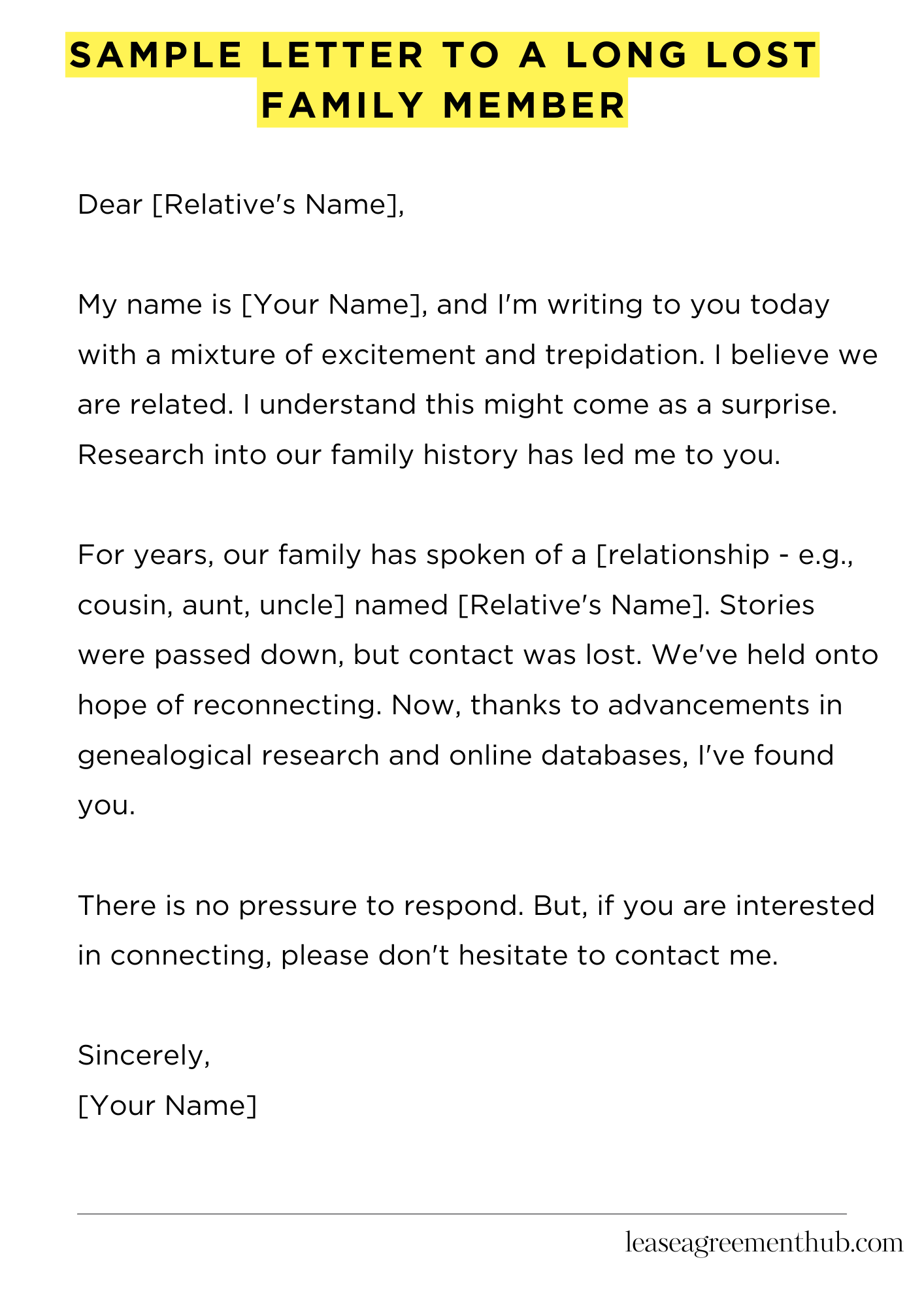Finding a long-lost family member is exciting. Connecting can be hard. A letter is a great start. This helps you reach out and reconnect.
This article gives you helpful examples. We share different letter templates. These samples make writing easier. They’re adaptable to your situation.
Use these samples as a guide. Craft a personal message. Reunite with your family. We hope this helps!
Sample Letter to a Long Lost Family Member
[Your Name]
[Your Address]
[Your Phone Number]
[Your Email Address]
[Date]
[Relative’s Name]
[Relative’s Address] (If known, otherwise omit)
Dear [Relative’s Name],
My name is [Your Name], and I’m writing to you today with a mixture of excitement and trepidation. I believe we are related. I understand this might come as a surprise. Research into our family history has led me to you.
For years, our family has spoken of a [relationship – e.g., cousin, aunt, uncle] named [Relative’s Name]. Stories were passed down, but contact was lost. We’ve held onto hope of reconnecting. Now, thanks to advancements in genealogical research and online databases, I’ve found you.
I understand that this may be unexpected. I wouldn’t want to intrude upon your life. However, I would be deeply grateful for the opportunity to learn more about you and our shared ancestry. Perhaps we could share some information about our families. Even a simple acknowledgment would mean the world to me.
I’ve attached a copy of my family tree, detailing our connection as far as I can trace it. Please take your time to consider my letter. There is no pressure to respond. But, if you are interested in connecting, please don’t hesitate to contact me.
Sincerely,
[Your Name]

How to Write a Sample Letter to a Long Lost Family Member
Reconnecting with estranged family can be a delicate endeavor. A thoughtfully composed letter offers a non-intrusive approach, allowing both parties time to process and respond. It’s a chance to bridge the chasm of time and rebuild familial bonds. This guide will elucidate the process of crafting such a letter.
Initiating Contact
Begin with a salutation appropriate to your relationship and the time elapsed. A simple “Dear [Name]” often suffices. Acknowledge the passage of time directly. Avoid platitudes. Instead, express your genuine desire to re-establish contact.
Explaining Your Motivation
Transparency is paramount. Articulate your reasons for seeking reconnection. Share your motivations openly and honestly. Perhaps you’re hoping to learn more about your family history, or simply wish to rekindle a lost connection. Avoid accusatory language or placing blame. Keep the tone conciliatory.
Sharing Personal Updates
Offer a concise synopsis of your life since the separation. Mention significant milestones, like marriage, children, or career achievements. These details provide context and foster common ground. However, avoid overwhelming them with minutiae. Focus on key life events.
Acknowledging the Past
While delving into past grievances may be tempting, approach this cautiously. If the separation was fraught, acknowledge the past without rehashing old wounds. Express a desire for reconciliation and understanding. Prioritize a forward-looking perspective. Focus on rebuilding the relationship.
Extending an Invitation
Propose a method of further communication. Offer your phone number, email address, or social media handles. Suggest a phone call, video chat, or even an in-person meeting, if feasible. Express your willingness to adapt to their preferred mode of communication. Respect their potential hesitation.
Concluding with Hope
Conclude your letter with a hopeful and optimistic tone. Reiterate your desire for reconciliation. Express your anticipation for their response, while acknowledging that they may need time to consider. Close with a warm and sincere valediction, such as “Warmly” or “With hope.” Offer your best wishes for their well-being
FAQs about sample letter to a long lost family member
Reconnecting with long-lost family members can be an emotional journey. Crafting the initial letter is a crucial first step.
How do I start a letter to a long-lost family member I’ve never met?
Begin by introducing yourself and explaining your relationship to the family. Clearly state how you discovered them and your reason for reaching out. Keep the tone warm and inviting, but avoid overwhelming them with too much information at once. For example, you might start with, “My name is [Your Name], and I’m writing to you because I’ve recently discovered that we are [Relationship, e.g., cousins].”
What information should I include in my letter?
Include details about your life, family, and upbringing. Share interesting anecdotes or family stories you know that might resonate with them. Mention any mutual family members or shared history you are aware of. Be concise and focus on creating a connection rather than overwhelming them with a detailed family tree.
How can I make my letter sound personal and genuine?
Avoid overly formal language. Write in a conversational tone as if you’re writing to a friend you haven’t seen in a while. Share personal experiences and feelings that demonstrate your genuine interest in connecting. Mention specific things you’d like to know about them or shared interests you might have.
What is the best way to end a letter to a long-lost relative?
Offer a way to continue the conversation. Provide your contact information (phone number and/or email address) and express your hope for a response. You might end with something like, “I hope to hear from you soon. Please feel free to contact me at [Your Contact Information].”
Should I send a photograph with my letter?
Including a recent photograph can help personalize the letter and make it more relatable. It provides a visual connection and helps your long-lost relative put a face to the name. Choose a clear, friendly photograph of yourself.
Related: